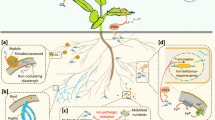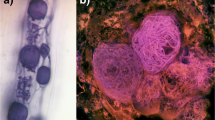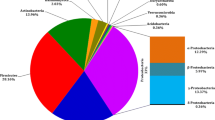Abstract
Key message
Symbiotic nitrogen fixation in root nodules of legumes is a highly important biological process which is only poorly understood. Root nodule metabolism differs from that of roots. Differences in root and nodule metabolism are expressed by altered protein abundances and amenable to quantitative proteome analyses. Differences in the proteomes may either be tissue specific and related to the presence of temporary endosymbionts (the bacteroids) or related to nitrogen fixation activity. An experimental setup including WT bacterial strains and strains not able to conduct symbiotic nitrogen fixation as well as root controls enables identification of tissue and nitrogen fixation specific proteins.
Abstract
Root nodules are specialized plant organs housing and regulating the mutual symbiosis of legumes with nitrogen fixing rhizobia. As such, these organs fulfill unique functions in plant metabolism. Identifying the proteins required for the metabolic reactions of nitrogen fixation and those merely involved in sustaining the rhizobia:plant symbiosis, is a challenging task and requires an experimental setup which allows to differentiate between these two physiological processes. Here, quantitative proteome analyses of nitrogen fixing and non-nitrogen fixing nodules as well as fertilized and non-fertilized roots were performed using Vicia faba and Rhizobium leguminosarum. Pairwise comparisons revealed altered enzyme abundance between active and inactive nodules. Similarly, general differences between nodules and root tissue were observed. Together, these results allow distinguishing the proteins directly involved in nitrogen fixation from those related to nodulation. Further observations relate to the control of nodulation by hormones and provide supportive evidence for the previously reported correlation of nitrogen and sulfur fixation in these plant organs. Additionally, data on altered protein abundance relating to alanine metabolism imply that this amino acid may be exported from the symbiosomes of V. faba root nodules in addition to ammonia. Data are available via ProteomeXchange with identifier PXD008548.







Similar content being viewed by others
References
Allaway D, Lodwig EM, Crompton LA, Wood M, Parsons R, Wheeler TR, Poole PS (2000) Identification of alanine dehydrogenase and its role in mixed secretion of ammonium and alanine by pea bacteroids. Mol Microbiol 36:508–515
Appels MA, Haaker H (1991) Glutamate oxaloacetate transaminase in pea root nodules. Plant Physiol 95:740–747
Barratt DHP, Barber L, Kruger NJ, Smith AM, Wang TL, Martin C (2001) Multiple, distinct isoforms of sucrose synthase in pea. Plant Physiol 127:655–664
Bestel-Corre G, Dumas-Gaudot E, Poinsot V, Dieu M, Dierick J-F, van Tuinen D, Remacle J, Gianinazzi-Pearson V, Gianinazzi S (2002) Proteome analysis and identification of symbiosis-related proteins from Medicago truncatula Gaertn. by two-dimensional electrophoresis and mass spectrometry. Electrophoresis 23:122–137
Biederbeck VO, Campbell CA, Rasiah V, Zentner RP, Wen G (1998) Soil quality attributes as influenced by annual legumes used as green manure. Soil Biol Biochem 30:1177–1185. https://doi.org/10.1016/S0038-0717(97)00150-8
Carvalho-Niebel F de, Timmers ACJ, Chabaud M, Defaux-Petras A, Barker DG (2002) The Nod factor-elicited annexin MtAnn1 is preferentially localised at the nuclear periphery in symbiotically activated root tissues of Medicago truncatula. Plant J 32:343–352. https://doi.org/10.1046/j.1365-313X.2002.01429.x
Clarke VC, Loughlin PC, Gavrin A, Chen C, Brear EM, Day DA, Smith PMC (2015) Proteomic analysis of the soybean symbiosome identifies new symbiotic proteins. Mol Cell Proteomics 14:1301–1322. https://doi.org/10.1074/mcp.M114.043166
Cox J, Mann M (2008) MaxQuant enables high peptide identification rates, individualized p.p.b.-range mass accuracies and proteome-wide protein quantification. Nat Biotechnol 26:1367–1372. https://doi.org/10.1038/nbt.1511
Day DA, Poole PS, Tyerman SD, Rosendahl L (2001) Ammonia and amino acid transport across symbiotic membranes in nitrogen-fixing legume nodules. Cell Mol Life Sci 58:61–71. https://doi.org/10.1007/PL00000778
Delmotte N, Ahrens CH, Knief C, Qeli E, Koch M, Fischer H-M, Vorholt JA, Hennecke H, Pessi G (2010) An integrated proteomics and transcriptomics reference data set provides new insights into the Bradyrhizobium japonicum bacteroid metabolism in soybean root nodules. J Proteomics 10:1391–1400. https://doi.org/10.1002/pmic.200900710
Djordjevic MA (2004) Sinorhizobium meliloti metabolism in the root nodule: a proteomic perspective. J Proteomics 4:1859–1872. https://doi.org/10.1002/pmic.200300802
Farnham MW, Miller SS, Griffith SM, Vance CP (1990) Aspartate aminotransferase in alfalfa root nodules: II. Immunological distinction between two forms of the enzyme. Plant Physiol 93:603–610. https://doi.org/10.1104/pp.93.2.603
Flemetakis E, Efrose RC, Desbrosses G, Dimou M, Delis C, Aivalakis G, Udvardi MK, Katinakis P (2004) Induction and spatial organization of polyamine biosynthesis during nodule development in Lotus japonicus. Mol Plant Microbe Interact 17:1283–1293. https://doi.org/10.1094/MPMI.2004.17.12.1283
Fontecave M, Atta M, Mulliez E (2004) S-adenosylmethionine: nothing goes to waste. Trends Biochem Sci 29:243–249. https://doi.org/10.1016/j.tibs.2004.03.007
Forrest SI, Verma DPS, Dhindsa RS (1991) Starch content and activities of starch-metabolizing enzymes in effective and ineffective root nodules of soybean. Can J Bot 69:697–701. https://doi.org/10.1139/b91-094
Fred EB, Baldwin IL, McCoy E, Triplett EW (2002) Root nodule bacteria and leguminous plants. University of Wisconsin studies in science, No. 5. Parallel Press, Madison
Fromm S, Senkler J, Eubel H, Peterhansel C, Braun H-P (2016) Life without complex I: proteome analyses of an Arabidopsis mutant lacking the mitochondrial NADH dehydrogenase complex. J Exp Bot 67:3079–3093. https://doi.org/10.1093/jxb/erw165
Gil-Quintana E, Lyon D, Staudinger C, Wienkoop S, González EM (2015) Medicago truncatula and Glycine max: different drought tolerance and similar local response of the root nodule proteome. J Proteome Res 14:5240–5251. https://doi.org/10.1021/acs.jproteome.5b00617
Gordon AJ, James CL (1997) Enzymes of carbohydrate and amino acid metabolism in developing and mature nodules of white clover. J Exp Bot 48:895–903. https://doi.org/10.1093/jxb/48.4.895
Graham PH (2003) Legumes: importance and constraints to greater use. Plant Physiol 131:872–877. https://doi.org/10.1104/pp.017004
Guerreiro N, Redmond JW, Rolfe BG, Djordjevic MA (1997) New Rhizobium leguminosarum flavonoid-induced proteins revealed by proteome analysis of differentially displayed proteins. MPMI 10:506–516. https://doi.org/10.1094/MPMI.1997.10.4.506
Hayakawa T, Sakai T, Ishiyama K, Hirose N, Nakajima H, Takezewa M, Naito K, Hino-Nakayama M, Akagawa T, Goto S, Yamaya T (2003) Organization and structure of ferredoxin-dependent glutamate synthase gene and intracellular localization of the enzyme in rice plants. Plant Biotech 20:43–55
Hoa LT-P (2004) Proteomic analysis on symbiotic differentiation of mitochondria in soybean nodules. Plant Cell Physiol 45:300–308. https://doi.org/10.1093/pcp/pch035
Hoagland DR, Arnon DI (1950) The water-culture method for growing plants without soil. Circ Calif Agric Exp Station 347:1–32
Hoffman BM, Lukoyanov D, Yang Z-Y, Dean DR, Seefeldt LC (2014) Mechanism of nitrogen fixation by nitrogenase: the next stage. Chem Rev 114:4041–4062. https://doi.org/10.1021/cr400641x
Kalloniati C, Krompas P, Karalias G, Udvardi MK, Rennenberg H, Herschbach C, Flemetakis E (2015) Nitrogen-fixing nodules are an important source of reduced sulfur, which triggers global changes in sulfur metabolism in Lotus japonicus. Plant Cell 27:2384–2400. https://doi.org/10.1105/tpc.15.00108
Koch M, Delmotte N, Rehrauer H, Vorholt JA, Pessi G, Hennecke H (2010) Rhizobial adaptation to hosts, a new facet in the legume root-nodule symbiosis. MPMI 23:784–790. https://doi.org/10.1094/MPMI-23-6-0784
Kouchi H, Shimomura K, Hata S, Hirota A, Wu GJ, Kumagai H, Tajima S, Suganuma N, Suzuki A, Aoki T, Hayashi M, Yokoyama T, Ohyama T, Asamizu E, Kuwata C, Shibata D, Tabata S (2004) Large-scale analysis of gene expression profiles during early stages of root nodule formation in a model legume, Lotus japonicus. DNA Res 11:263–274
Kumar S, Bourdès A, Poole P (2005) De novo alanine synthesis by bacteroids of Mesorhizobium loti is not required for nitrogen transfer in the determinate nodules of Lotus corniculatus. J Bacteriol 187:5493–5495. https://doi.org/10.1128/JB.187.15.5493-5495.2005
Küster H, Albus U, Frühling M, Tchetkova SA, Tikhonovitch IA, Pühler A, Perlick AM (1997) The asparagine synthetase gene VfAS1 is strongly expressed in the nitrogen-fixing zone of broad bean (Vicia faba L.) root nodules. Plant Sci 124:89–95. https://doi.org/10.1016/S0168-9452(97)04607-4
Larrainzar E, Wienkoop S, Weckwerth W, Ladrera R, Arrese-Igor C, Gonzalez EM (2007) Medicago truncatula root nodule proteome analysis reveals differential plant and bacteroid responses to drought stress. Plant Physiol 144:1495–1507. https://doi.org/10.1104/pp.107.101618
Li Y, Parsons R, Day DA, Bergersen FJ (2002) Reassessment of major products of N2 fixation by bacteroids from soybean root nodules. Microbiology 148:1959–1966. https://doi.org/10.1099/00221287-148-6-1959
Li W, Liu B, Yu L, Feng D, Wang H, Wang J (2009) Phylogenetic analysis, structural evolution and functional divergence of the 12-oxo-phytodienoate acid reductase gene family in plants. BMC Evol Biol 9:90. https://doi.org/10.1186/1471-2148-9-90
Liepman AH, Olsen LJ (2003) Alanine aminotransferase homologs catalyze the glutamate:glyoxylate aminotransferase reaction in peroxisomes of Arabidopsis. Plant Physiol 131:215–227. https://doi.org/10.1104/pp.011460
Lodwig EM, Hosie AH, Bourdès A, Findlay K, Allaway D, Karunakaran R, Downie JA, Poole PS (2003) Amino-acid cycling drives nitrogen fixation in the legume-rhizobium symbiosis. Nature 422:722–726. https://doi.org/10.1038/nature01527
Lodwig E, Kumar S, Allaway D, Bourdès A, Prell J, Priefer U, Poole P (2004) Regulation of l-alanine dehydrogenase in Rhizobium leguminosarum bv. viciae and its role in pea nodules. J Bacteriol 186::842–849. https://doi.org/10.1128/JB.186.3.842-849.2004
Ma Q-S, Johnston AWB, Hombrecher G, Downie JA (1982) Molecular genetics of mutants of Rhizobium leguminosarum which fail to fix nitrogen. Mol Gen Genet 187:166–171. https://doi.org/10.1007/BF00384401
Marx H, Minogue CE, Jayaraman D, Richards AL, Kwiecien NW, Siahpirani AF, Rajasekar S, Maeda J, Garcia K, Del Valle-Echevarria AR, Volkening JD, Westphall MS, Roy S, Sussman MR, Ané J-M, Coon JJ (2016) A proteomic atlas of the legume Medicago truncatula and its nitrogen-fixing endosymbiont Sinorhizobium meliloti. Nat Biotechnol 34:1198–1205. https://doi.org/10.1038/nbt.3681
Morell M, Copeland L (1985) Sucrose synthase of soybean nodules. Plant Physiol 78:149–154. https://doi.org/10.1104/pp.78.1.149
Neuhoff V, Stamm R, Eibl H (1985) Clear background and highly sensitive protein staining with coomassie blue dyes in polyacrylamide gels: a systematic analysis. Electrophoresis 6:427–448. https://doi.org/10.1002/elps.1150060905
Nomura M (2006) Phosphoenolpyruvate carboxylase plays a crucial role in limiting nitrogen fixation in Lotus japonicus nodules. Plant Cell Physiol 47:613–621. https://doi.org/10.1093/pcp/pcj028
Ohyama T, Kumazawa K (1980) Nitrogen assimilation in soybean nodules. Soil Sci Plant Nutr 26:109–115. https://doi.org/10.1080/00380768.1980.10433217
Oldroyd GE, Downie JA (2008) Coordinating nodule morphogenesis with rhizobial infection in legumes. Annu Rev Plant Biol 59:519–546. https://doi.org/10.1146/annurev.arplant.59.032607.092839
Oldroyd GED, Murray JD, Poole PS, Downie JA (2011) The rules of engagement in the legume-rhizobial symbiosis. Annu Rev Genet 45:119–144. https://doi.org/10.1146/annurev-genet-110410-132549
Prell J, White JP, Bourdes A, Bunnewell S, Bongaerts RJ, Poole PS (2009) Legumes regulate rhizobium bacteroid development and persistence by the supply of branched-chain amino acids. Proc Natl Acad Sci USA 106:12477–12482. https://doi.org/10.1073/pnas.0903653106
Puppo A, Groten K, Bastian F, Carzaniga R, Soussi M, Lucas MM, Felipe MR de, Harrison J, Vanacker H, Foyer CH (2005) Legume nodule senescence: roles for redox and hormone signalling in the orchestration of the natural aging process. New Phytol 165:683–701. https://doi.org/10.1111/j.1469-8137.2004.01285.x
Ravanel S, Gakiere B, Job D, Douce R (1998) The specific features of methionine biosynthesis and metabolism in plants. Proc Natl Acad Sci USA 95:7805–7812
Rawsthorne S, Minchin FR, Summerfield RJ, Cookson C, Coombs J (1980) Carbon and nitrogen metabolism in legume root nodules. Phytochemistry 19:341–355. https://doi.org/10.1016/0031-9422(80)83181-5
Rosendahl L, Dilworth MJ, Glenn AR (1992) Exchange of metabolites across the peribacteroid membrane in pea root nodules. J Plant Physiol 139:635–638
Salavati A, Shafeinia A, Klubicova K, Bushehri AAS, Komatsu S (2013) Proteomic insights into intra- and intercellular plant-bacteria symbiotic association during root nodule formation. Front Plant Sci 4:28. https://doi.org/10.3389/fpls.2013.00028
Shen B, Li C, Tarczynski MC (2002) High free-methionine and decreased lignin content result from a mutation in the Arabidopsis S-adenosyl-l-methionine synthetase 3 gene. Plant J 29:371–380
Stefansson S, Chung DS, Yoon J, Yoo WS, Park YW, Kim G, Hahn D, Le H, Chung S-J, Bruttig SP, Ho DH (2016) Improving oxygen binding of desiccated human red blood cells. ABB 07:47–54. https://doi.org/10.4236/abb.2016.72006
Sun J, Cardoza V, Mitchell DM, Bright L, Oldroyd G, Harris JM (2006) Crosstalk between jasmonic acid, ethylene and nod factor signaling allows integration of diverse inputs for regulation of nodulation. Plant J 46:961–970. https://doi.org/10.1111/j.1365-313X.2006.02751.x
Tate R, Patriarca EJ, Riccio A, Defez R, Iaccarino M (1994) Development of Phaseolus vulgaris root nodules. MPMI 7:582–589
Terakado J, Yoneyama T, Fujihara S (2006) Shoot-applied polyamines suppress nodule formation in soybean (Glycine max). Plant Physiol 163:497–505. https://doi.org/10.1016/j.jplph.2005.05.007
Tyanova S, Temu T, Sinitcyn P, Carlson A, Hein MY, Geiger T, Mann M, Cox J (2016) The Perseus computational platform for comprehensive analysis of (prote)omics data. Nat Methods 13:731–740. https://doi.org/10.1038/nmeth.3901
Tyerman SD, Whitehead LF, Day DA (1995) A channel-like transporter for NH4+ on the symbiotic interface of N2-fixing plants. Nature 378:629–632. https://doi.org/10.1038/378629a0
Udvardi MK, Day DA (1997) Metabolite transport across symbiotic membranes of legume nodules. Annu Rev Plant Biol 48:493–523. https://doi.org/10.1146/annurev.arplant.48.1.493
Udvardi M, Poole PS (2013) Transport and metabolism in legume-rhizobia symbioses. Annu Rev Plant Biol 64:781–805. https://doi.org/10.1146/annurev-arplant-050312-120235
van Noorden GE, Kerim T, Goffard N, Wiblin R, Pellerone FI, Rolfe BG, Mathesius U (2007) Overlap of proteome changes in Medicago truncatula in response to auxin and Sinorhizobium meliloti. Plant Physiol 144:1115–1131. https://doi.org/10.1104/pp.107.099978
van Wees SCM, van der Ent S, Pieterse CMJ (2008) Plant immune responses triggered by beneficial microbes. Curr Opin Plant Biol 11:443–448. https://doi.org/10.1016/j.pbi.2008.05.005
Vance CP, Heichel GH (1991) Carbon in N2 fixation: limitation or exquisite adaptation. Annu Rev Plant Biol 42(1):373–390
Vance CP, Miller SS, Gregerson RG, Samac DA, Robinson DL, Gantt JS (1995) Alfalfa NADH-dependent glutamate synthase: structure of the gene and importance in symbiotic N2 fixation. Plant J 8:345–358. https://doi.org/10.1046/j.1365-313X.1995.08030345.x
Wang C, Xu X, Hong Z, Feng Y, Zhang Z (2015) Involvement of ROP6 and clathrin in nodulation factor signaling. Plant Signal Behav 10:e1033127. https://doi.org/10.1080/15592324.2015.1033127
Waters JK, Hughes BL, Purcell LC, Gerhardt KO, Mawhinney TP, Emerich DW (1998) Alanine, not ammonia, is excreted from N(2)-fixing soybean nodule bacteroids. Proc Natl Acad Sci USA 95:12038–12042
Weise SE, van Wijk KJ, Sharkey TD (2011) The role of transitory starch in C(3), CAM, and C(4) metabolism and opportunities for engineering leaf starch accumulation. J Exp Bot 62:3109–3118. https://doi.org/10.1093/jxb/err035
Welham T, Pike J, Horst I, Flemetakis E, Katinakis P, Kaneko T, Sato S, Tabata S, Perry J, Parniske M, Wang TL (2009) A cytosolic invertase is required for normal growth and cell development in the model legume, Lotus japonicus. J Exp Bot 60:3353–3365. https://doi.org/10.1093/jxb/erp169
Wheeler CT (1969) The diurnal fluctuation in nitrogen fixation in the nodules of Alnus glutinosa and Myrica gale. New Phytol 68:675–682
Wienkoop S, Saalbach G (2003) Proteome analysis. Novel proteins identified at the peribacteroid membrane from Lotus japonicus root nodules. Plant Physiol 131:1080–1090. https://doi.org/10.1104/pp.102.015362
Wojciechowski MF, Lavin M, Sanderson MJ (2004) A phylogeny of legumes (Leguminosae) based on analysis of the plastid matK gene resolves many well-supported subclades within the family. Am J Bot 91:1846–1862. https://doi.org/10.3732/ajb.91.11.1846
Young ND, Udvardi M (2009) Translating Medicago truncatula genomics to crop legumes. Curr Opin Plant Biol 12:193–201. https://doi.org/10.1016/j.pbi.2008.11.005
Zdyb A, Demchenko K, Heumann J, Mrosk C, Grzeganek P, Göbel C, Feussner I, Pawlowski K, Hause B (2011) Jasmonate biosynthesis in legume and actinorhizal nodules. New Phytol 189:568–579. https://doi.org/10.1111/j.1469-8137.2010.03504.x
Acknowledgements
We thank Prof. Dr. Ursula B. Priefer and Prof. Dr. Allan Downie for providing the Rhizobium leguminosarum strains Fix+ and Fix−. Our research was supported by the Deutsche Forschungsgemeinschaft (DFG) in the frame of the Graduiertenkolleg Signaling at the plant Soil interface (GRK1798).
Author information
Authors and Affiliations
Contributions
BT conducted all experiments participated in preparation of the manuscript. H-PB participated in the planning of experiments and preparation of the manuscript. HE planned the experiments and participated in the preparation of the manuscript.
Corresponding author
Electronic supplementary material
Below is the link to the electronic supplementary material.
11103_2018_736_MOESM6_ESM.pdf
Suppl. Figure 1: Testing of protein sequence databases for cross species protein identification. Among the three databases, two are species independent and contain a broad spectrum of proteins from all kingdoms of life (NCBInr, SwissProt, both of which were downloaded in Jnuaury 2018) while the third database is a custom made, in house database containing the protein sequences of V. faba, R. leguminosarum, as well as frequent contaminants. One Fix- sample could not be analyzed using our bioinformatics platform, most likely due to memory constraints. In all cases, the in-house M. truncatula and R. leguminosarum database identified more proteins than the two broad species databases, probably due to increased statistical uncertainties inherent to large-scale databases with too many entries. (PDF 168 KB)
11103_2018_736_MOESM7_ESM.pdf
Suppl. Figure 2: Altered cellular processes in Fix+ compared to Fix- and N. Bars indicate the number of altered proteins associated with a given cellular function. Upper panel: Fix+ (red bars) opposed to Fix- (yellow bars). Lower panel compares Fix+ with N (blue bars). AdoMet, S-Adenosyl methionine; OXPHOS, oxidative phosphorylation system; TCA, tricarboxylic acid cycle; PPP, pentose phosphate pathway. (PDF 450 KB)
11103_2018_736_MOESM8_ESM.pdf
Suppl. Figure 3: Pairwise comparisons and meta-comparisons between the four sample groups. The four sample groups differ in two aspects i) nodule formation (true for Fix+ and Fix-, false for N and 0) and ii) nitrogen status (high for Fix+ and N, low for Fix- and 0). Six comparisons are conceivable between the four groups (grey full and dashed arrows) but only the full arrows allow comparison of groups differing only in a single aspect (nodulation or nitrogen status). Pairwise comparisons were thus limited to these combinations. The comparisons of Fix+ with Fix- and of Fix+ with N as these allow the identification of proteins specific for symbiotic nitrogen fixation via a meta comparison (MC) approach (MC1). In a second meta comparison (MC2) the nodule forming groups are compared with N and 0 to pinpoint symbiosis related proteins. (PDF 167 KB)
11103_2018_736_MOESM9_ESM.pdf
Suppl. Figure 4: Mean abundance of core plant and bacteroid SNF enzymes. Significant differences (t-test) between the sample groups are indicated by a star (p<0.05). AS1, asparagine synthase (Medtr3g464580.1, Medtr3g464580.2, Medtr3g464580.3); AS2, glutamine-dependent asparagine synthase 1 (Medtr5g071360.1-2); AspAT1, aspartate aminotransferase (Medtr8g091280.1); AspAT2 (Medtr1g013050.1); AspAT3, aspartate aminotransferase (Medtr3g110065.1-3); GOGAT, ferredoxin-dependent glutamate synthase (Medtr7g089970.1); GDH, NADP-specific glutamate dehydrogenase (Medtr7g085630.1-6); GS1, glutamine synthetase (Medtr2g021255.1-2); GS2, glutamine synthetase domain protein (Medtr6g071070.1); GS3, (Medtr3g065250.1, Medtr5g077950.1); NifD, Nitrogenase (molybdenum-iron) alpha chain (pRL100161); NifH, Nitrogenase iron protein (pRL100162); NifK, Nitrogenase (molybdenum-iron) beta chain (pRL100160); NifN, Nitrogenase FeMo-cofactor scaffold and assembly protein (pRL100158); PEPC1, phosphoenolpyruvate carboxylase (Medtr2g092930.1); PEPC2 (Medtr4g079860.1); PEPC3 (Medtr2g076670.1-3); PEPC4 (Medtr8g463920.1-3). (PDF 526 KB)
11103_2018_736_MOESM10_ESM.pdf
Suppl. Fig. 5: Response of seven proteins commonly found in MC1 and MC2 to SNF activity (Fix+/Fix-) as well as nodulation and SNF activity (Fix+/N). Altered protein abundance are expressed in log2 (fold) change between the groups as derived from pairwise comparisons. (PDF 172 KB)
Rights and permissions
About this article
Cite this article
Thal, B., Braun, HP. & Eubel, H. Proteomic analysis dissects the impact of nodulation and biological nitrogen fixation on Vicia faba root nodule physiology. Plant Mol Biol 97, 233–251 (2018). https://doi.org/10.1007/s11103-018-0736-7
Received:
Accepted:
Published:
Issue Date:
DOI: https://doi.org/10.1007/s11103-018-0736-7




